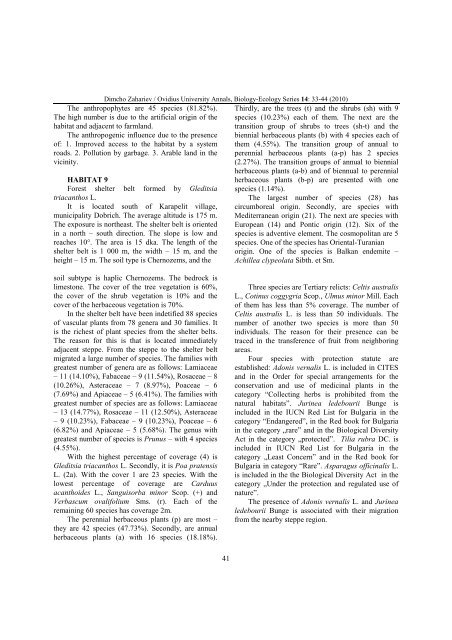VOLUM OMAGIAL - Facultatea de Ştiinţe ale Naturii şi Ştiinţe Agricole
VOLUM OMAGIAL - Facultatea de Ştiinţe ale Naturii şi Ştiinţe Agricole
VOLUM OMAGIAL - Facultatea de Ştiinţe ale Naturii şi Ştiinţe Agricole
You also want an ePaper? Increase the reach of your titles
YUMPU automatically turns print PDFs into web optimized ePapers that Google loves.
Dimcho Zahariev / Ovidius University Annals, Biology-Ecology Series 14: 33-44 (2010)<br />
The anthropophytes are 45 species (81.82%).<br />
The high number is due to the artificial origin of the<br />
habitat and adjacent to farmland.<br />
The anthropogenic influence due to the presence<br />
of: 1. Improved access to the habitat by a system<br />
roads. 2. Pollution by garbage. 3. Arable land in the<br />
vicinity.<br />
HABITAT 9<br />
Forest shelter belt formed by Gleditsia<br />
triacanthos L.<br />
It is located south of Karapelit village,<br />
municipality Dobrich. The average altitu<strong>de</strong> is 175 m.<br />
The exposure is northeast. The shelter belt is oriented<br />
in a north – south direction. The slope is low and<br />
reaches 10°. The area is 15 dka. The length of the<br />
shelter belt is 1 000 m, the width – 15 m, and the<br />
height – 15 m. The soil type is Chernozems, and the<br />
soil subtype is haplic Chernozems. The bedrock is<br />
limestone. The cover of the tree vegetation is 60%,<br />
the cover of the shrub vegetation is 10% and the<br />
cover of the herbaceous vegetation is 70%.<br />
In the shelter belt have been in<strong>de</strong>tified 88 species<br />
of vascular plants from 78 genera and 30 families. It<br />
is the richest of plant species from the shelter belts.<br />
The reason for this is that is located immediately<br />
adjacent steppe. From the steppe to the shelter belt<br />
migrated a large number of species. The families with<br />
greatest number of genera are as follows: Lamiaceae<br />
– 11 (14.10%), Fabaceae – 9 (11.54%), Rosaceae – 8<br />
(10.26%), Asteraceae – 7 (8.97%), Poaceae – 6<br />
(7.69%) and Apiaceae – 5 (6.41%). The families with<br />
greatest number of species are as follows: Lamiaceae<br />
– 13 (14.77%), Rosaceae – 11 (12.50%), Asteraceae<br />
– 9 (10.23%), Fabaceae – 9 (10.23%), Poaceae – 6<br />
(6.82%) and Apiaceae – 5 (5.68%). The genus with<br />
greatest number of species is Prunus – with 4 species<br />
(4.55%).<br />
With the highest percentage of coverage (4) is<br />
Gleditsia triacanthos L. Secondly, it is Poa pratensis<br />
L. (2а). With the cover 1 are 23 species. With the<br />
lowest percentage of coverage are Carduus<br />
acanthoi<strong>de</strong>s L., Sanguisorba minor Scop. (+) and<br />
Verbascum ovalifolium Sms. (r). Each of the<br />
remaining 60 species has coverage 2m.<br />
The perennial herbaceous plants (p) are most –<br />
they are 42 species (47.73%). Secondly, are annual<br />
herbaceous plants (a) with 16 species (18.18%).<br />
41<br />
Thirdly, are the trees (t) and the shrubs (sh) with 9<br />
species (10.23%) each of them. The next are the<br />
transition group of shrubs to trees (sh-t) and the<br />
biennial herbaceous plants (b) with 4 species each of<br />
them (4.55%). The transition group of annual to<br />
perennial herbaceous plants (а-р) has 2 species<br />
(2.27%). The transition groups of annual to biennial<br />
herbaceous plants (а-b) and of biennual to perennial<br />
herbaceous plants (b-р) are presented with one<br />
species (1.14%).<br />
The largest number of species (28) has<br />
circumboreal origin. Secondly, are species with<br />
Mediterranean origin (21). The next are species with<br />
European (14) and Pontic origin (12). Six of the<br />
species is adventive element. The cosmopolitan are 5<br />
species. One of the species has Oriental-Turanian<br />
origin. One of the species is Balkan en<strong>de</strong>mite –<br />
Achillea clypeolata Sibth. et Sm.<br />
Three species are Tertiary relicts: Celtis australis<br />
L., Cotinus coggygria Scop., Ulmus minor Mill. Each<br />
of them has less than 5% coverage. The number of<br />
Celtis australis L. is less than 50 individuals. The<br />
number of another two species is more than 50<br />
individuals. The reason for their presence can be<br />
traced in the transference of fruit from neighboring<br />
areas.<br />
Four species with protection statute are<br />
established: Adonis vernalis L. is inclu<strong>de</strong>d in CITES<br />
and in the Or<strong>de</strong>r for special arrangements for the<br />
conservation and use of medicinal plants in the<br />
category “Collecting herbs is prohibited from the<br />
natural habitats”. Jurinea le<strong>de</strong>bourii Bunge is<br />
inclu<strong>de</strong>d in the IUCN Red List for Bulgaria in the<br />
category “Endangered”, in the Red book for Bulgaria<br />
in the category „rare” and in the Biological Diversity<br />
Act in the category „protected”. Tilia rubra DC. is<br />
inclu<strong>de</strong>d in IUCN Red List for Bulgaria in the<br />
category „Least Concern” and in the Red book for<br />
Bulgaria in category “Rare”. Asparagus officinalis L.<br />
is inclu<strong>de</strong>d in the the Biological Diversity Act in the<br />
category „Un<strong>de</strong>r the protection and regulated use of<br />
nature”.<br />
The presence of Adonis vernalis L. and Jurinea<br />
le<strong>de</strong>bourii Bunge is associated with their migration<br />
from the nearby steppe region.





